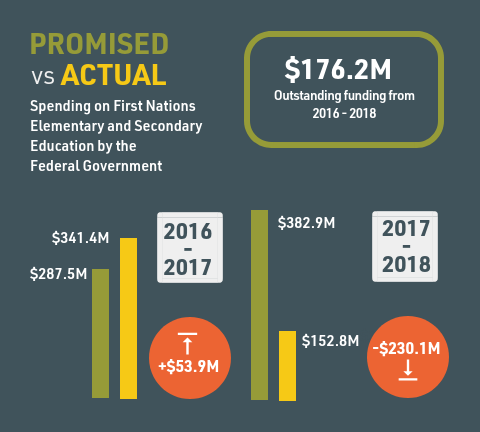- About
- Research
-
-
- Special Reports & Features
- Braiding Accountability: A Ten-Year Review of the TRC’s Healthcare Calls to Action
- Buried Burdens: The True Costs of Liquified Natural Gas (LNG) Ownership
- Pretendians and Publications: The Problem and Solutions to Redface Research
- Pinasunniq: Reflections on a Northern Indigenous Economy
- From Risk to Resilience: Indigenous Alternatives to Climate Risk Assessment in Canada
- Twenty-Five Years of Gladue: Indigenous ‘Over-Incarceration’ & the Failure of the Criminal Justice System on the Grand River
- Calls to Action Accountability: A 2023 Status Update on Reconciliation
- View all reports.
- Special Reports & Features
-
-
- Yellowhead School
-
- The Treaty Map
- LIBRARY
- Submissions
- Donate
UPDATE
There is new data available for the education funding Brief published last month. That Brief (below) utilizes figures from the Public Accounts of Canada. Public Accounts data comprises the sum of total expenditures in elementary and secondary education, and post-secondary education.
Since its publication, the Department of Indigenous Services Canada contacted Yellowhead with an answer to the question: why the funding disparity? They provided specific information with respect to expenditures in First Nations elementary and secondary education.
In the 2015-16 fiscal year, the Department spent $1.464.7B1 on Elementary and Secondary education out of a total education expenditure of $1.805.1B2 spent on First Nations education. Post-secondary education comprises the balance of expenditures ($340.4m).
There is a five-year commitment to add $2.6 billion3 to the 2015-16 total for Elementary and Secondary education. The Department clarified that new funds added each year do not create a new baseline. In other words, they are program expenditures over and above the funding which has historically been provided. The Department provided a graph to illustrate this point. The promise of $287.54 million in Year 1, 2016-17, is shown as being added to the 2015-16 baseline, but it does not change the baseline for Year 2 (2017-18).

The historic funding amount which serves as the baseline has been widely acknowledged as being inadequate to meet the needs of First Nations education, particularly First Nations schools, and has been subject to a two per-cent cap on annual increases for over two decades. The graph provided by the Department shows that the historic funding amount, represented by the blue line, gradually increases annually.
The chart provided by the Department suggests that the federal government has provided its Year 2 commitment of $382.9 million, and kept its promises for the first two years of its five-year commitment to First Nations Elementary and Secondary education. There is no additional information publicly available to confirm this information, but if it is the case, then it is a positive development, particularly for First Nations schools. This leaves a total of approximately $1.930 billion in additional funding out of the original $2.6 billion commitment remains to be allocated in 2018-19, 2019-20, and 2020-21.
In the meantime, there are ongoing deliberations between representatives of national and regional First Nations organizations, and the federal government, to develop new and modernized funding approaches, nationally, and regionally, to replace the inadequate and outdated funding model which has been in place for decades. Although it is a difficult task, it is critical that this work achieve success; current and future generations of First Nations students are depending on it.
FOR MANY YEARS, First Nations have highlighted the chronic under-funding of First Nation education in Canada.
The lack of resources meant First Nations often could not pay competitive salaries to teachers, provide culturally and linguistically relevant curriculum, or provide the types of support services to students which might be found in a typical provincial school. But during the 2015 federal election campaign each of the major political parties promised to provide significant amounts of new funding to support First Nations elementary and secondary education.
For their part, the Liberal Party of Canada announced that they would commit $2.6 billion in new funding upon being elected.
After the election there were initially positive signs of implementing this promise, but running the numbers reveals that Canada is in danger of breaking their promises on First Nation education.
In the 2016 federal budget, the federal government set out a schedule for releasing additional education funding. Here is an abridged version:
“Making Sure Every First Nations Child Receives a Quality Education”1

It is important to note that more than half of the committed funding ($1.4 billion) is slated to be released after the next federal election (next October) with no indication a new government will honour the pledge.
Still, according to Public Accounts of Canada, in 2016-17 the federal government increased spending on education by $341.4 million2, which is an 18.9% increase from the previous year.3 In 2017-18, education spending increased again by another $152.8 million or 7.1% more than the previous year.4
The increase in funding is a welcome relief from decades of austerity.
In the previous decade alone, from 2006 to 2016, total federal government spending on First Nations elementary and secondary education increased by an average of 1.14% per year. This is less than the devastating 2% cap on annual expenditure increases imposed in 1996-97 and kept in place for the next two decades.
However, the amount of funding provided in 2016-17 and 2017-18 falls significantly short of the commitment set out in the 2016 federal budget. Here are where more concerns arise.
In 2016-2017, the federal government actually spent $53.9 million more on First Nations education than they promised. Regrettably this trend did not last. In the second year, 2017-2018, they underspent by a whopping $230.1 million.
Over these two fiscal years, the federal government has withheld their promised allocation for First Nations elementary and secondary education by approximately $176.2 million.
Considering this, just 26.3% of the promised funding for 2016-17 and 2017-18 has been spent. With the federal election on the horizon, it is possible that less than half the committed government funding will actually be allocated.
Examining the budget for 2017-18 in a little more detail gives a sense of the specific programs and services are being neglected. The federal government budgeted $276.0 million for “Addressing Immediate Funding Needs and Program Cost Growth” ($85.5m), “Language and Culture” ($55m), “Literacy and Numeracy” ($20m), and “Special Needs Education” ($115.5m). These are areas relating directly to the operation of First Nations schools and the programs and services they provide to First Nations students. The underspending issues then are especially acute. How can this be explained?
The budget also includes $104.9 million for “Supporting System Transformation to Improve Education Outcomes”. This is a collaborative process through the Assembly of First Nations (AFN) to change federal policy and funding models with respect to First Nations education. According to AFN resolution #65-2017, the approach “Supports First Nations, through funded regional tables,5 to negotiate and conclude regional First Nation Education Agreements that will include their own education funding model that provides funding for the unique needs of First Nation students, communities and schools starting in 2018-19”.6
The development of regional entities and negotiating tables, and regionalized and localized funding models, are not matters which are likely to materialize overnight, and certainly subject to much discussion and debate.
Is the federal government waiting for an ideal political process before spending these resources?
A fulsome explanation on the refusal to finally and adequately fund First Nation education would be welcome from Canada. As the clock runs out on yet another government with good intentions, trust remains elusive.
We can only hope that the underspending in Year 2 of this multi-year commitment does not signal a return of a backwards trend for the future.
Endnotes
Update:
1Indigenous and Northern Affairs Canada: 2015–16 Departmental Performance Report – Supporting Information on Lower Level Programs, https://www.aadnc-aandc.gc.ca/eng/1466534062394/1466534104470#2_1_1
2Government of Canada: Public Accounts of Canada 2017-18 Volume II – Details of Expenses and Revenues https://www.tpsgc-pwgsc.gc.ca/recgen/cpc-pac/2018/vol2/intro-eng.html
3Government of Canada: Budget 2016 – Chapter 3 – A Better Future for Indigenous Peoples, https://www.budget.gc.ca/2016/docs/plan/ch3-en.html#_Toc446106726
4A detailed explanation of the Year 1 expenditures can be found here: https://www.sac-isc.gc.ca/eng/1516633592534/1531315146352
Original Brief
1Government of Canada, Table 3.1: Making Sure Every First Nations Child Receives a Quality Education, from Budget 2016, https://www.budget.gc.ca/2016/docs/plan/ch3-en.html#_Toc446106726, retrieved November 24, 2018.
2Receiver General of Canada: Public Accounts of Canada 2017 – Volume 2 Details of Revenues and Expenses, pp. 11.11. retrieved November 24, 2018 from http://epe.lac-bac.gc.ca/100/201/301/public_accounts_can/pdf/2017/2017-vol2-eng.pdf
3Receiver General of Canada: Public Accounts of Canada 2016 – Volume 2 Details of Revenues and Expenses, pp. 11.11. retrieved November 24, 2018 from http://epe.lac-bac.gc.ca/100/201/301/public_accounts_can/pdf/2016/2016-vol2-eng.pdf
4Receiver General of Canada: Public Accounts of Canada 2018 – Volume 2 Details of Revenues and Expenses, pp. 308 and pp. 322, retrieved November 24, 2018 from https://www.tpsgc-pwgsc.gc.ca/recgen/cpc-pac/2018/pdf/2018-vol2-eng.pdf
5According to Indigenous Services Canada, First Nations will determine what constitutes a ‘region’ for the purposes of their First Nation Education Agreement.
6 Assembly of First Nations: Resolution #65-2017 “New Interim Funding Approach for First Nation Education”, retrieved November 24, 2018 from https://www.afn.ca/wp-content/uploads/2017/02/2017-sca-res-v2.pdf
Citation: Thompson, Karihwakeron Tim. “UPDATE | The 176 Million Dollar Question: Are the Promised Federal Education Funds for First Nations Actually Flowing?” Yellowhead Institute, 4 Dec 2018, https://yellowheadinstitute.org/2018/12/04/federal-education-funds/


